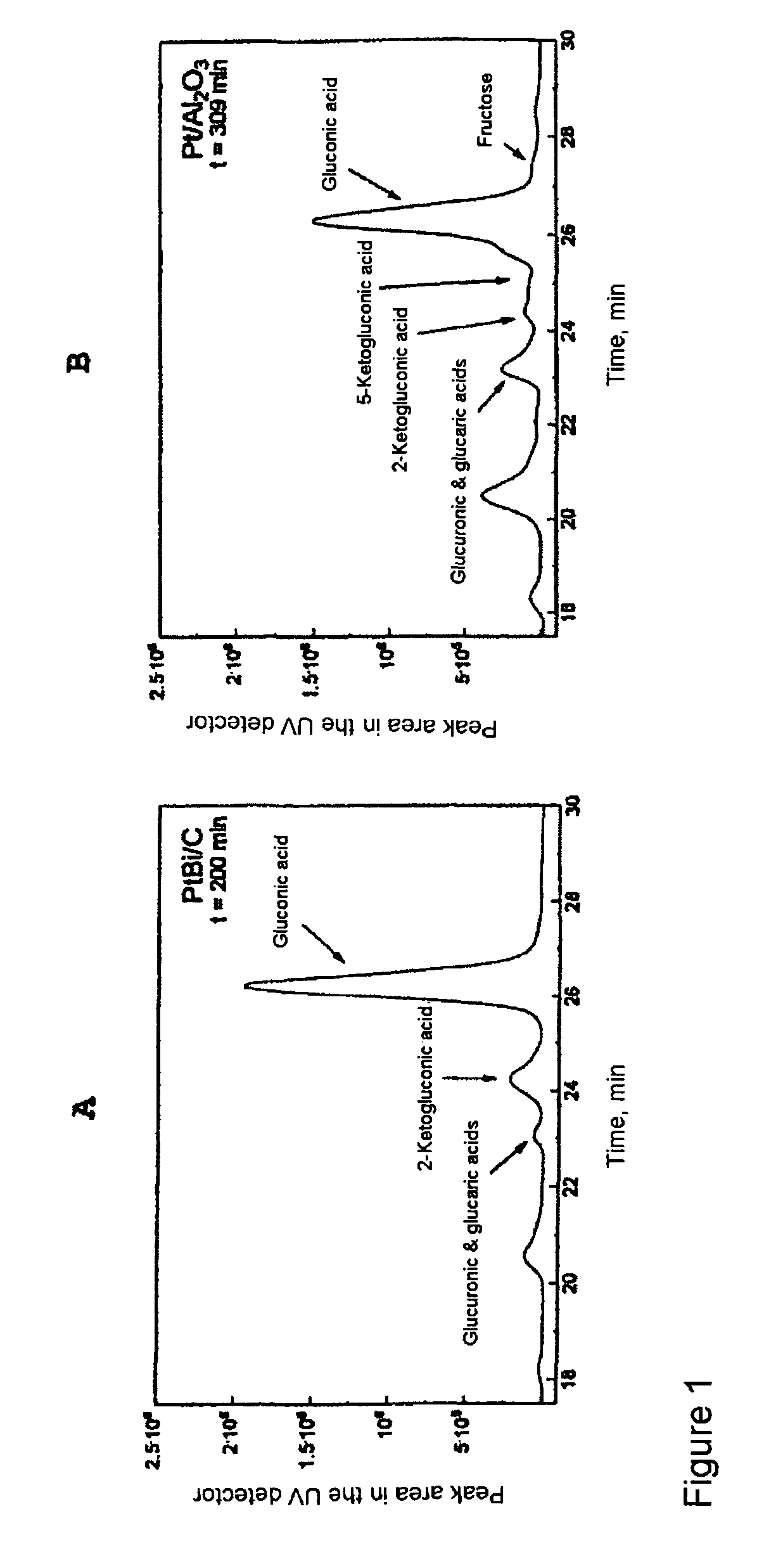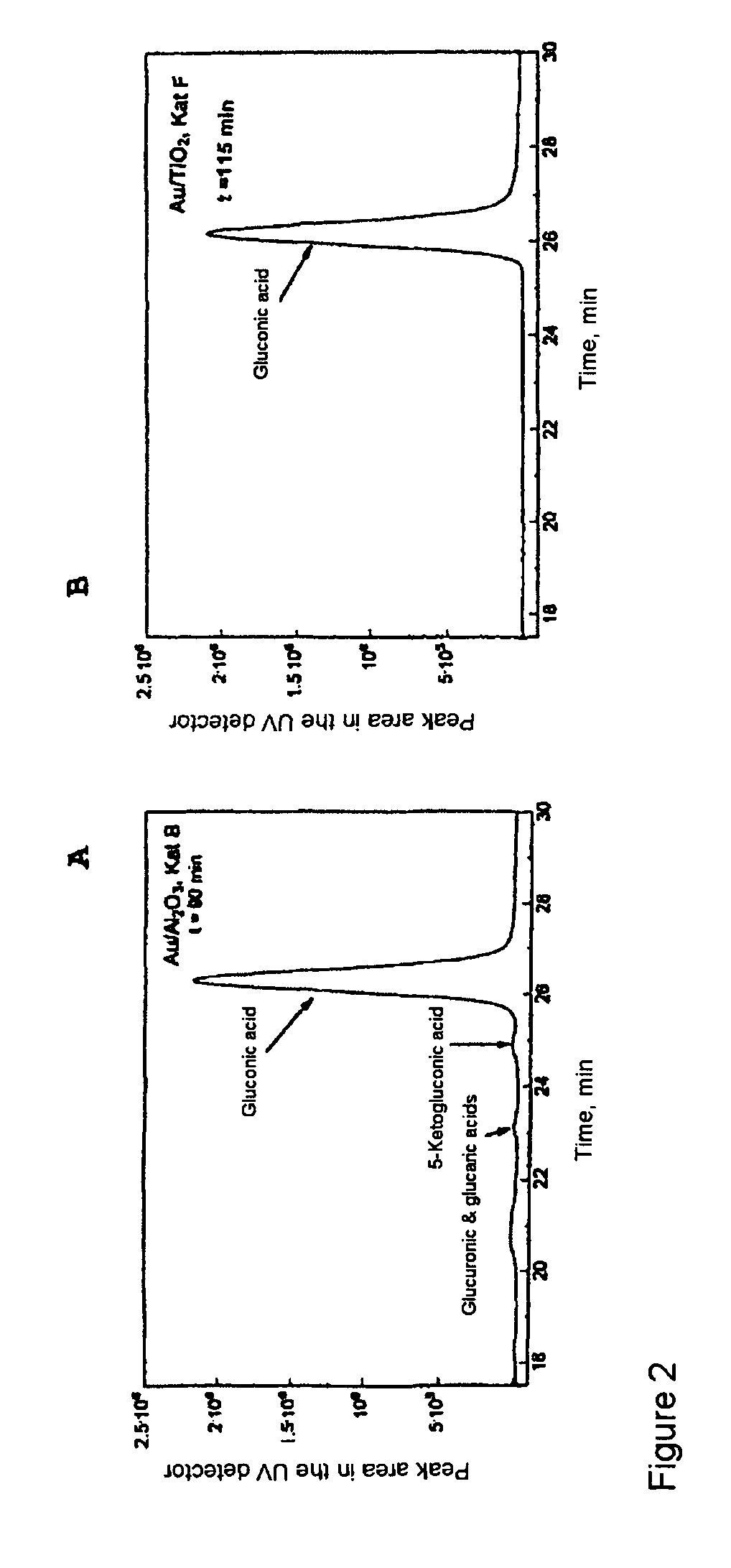Method for selective carbohydrate oxidation using supported gold catalysts
a technology of supported gold catalysts and carbohydrate oxidation, which is applied in the preparation of sugar derivatives, saccharides, sugar derivatives, etc., can solve the problems of disturbance of the ecological balance of watercourse, inability of people with lactose intolerance to utilize lactose and respond, and scarce economic importance of lactose as the principal carbohydrate constituent of milk, etc., to achieve high selectivity and activity
- Summary
- Abstract
- Description
- Claims
- Application Information
AI Technical Summary
Benefits of technology
Problems solved by technology
Method used
Image
Examples
example 1
Oxidation of Glucose with Use of Gold Catalysts
[0097]The following types of catalyst were employed for this example:[0098]A: 1% Au / C type 138 (ACA)[0099]B: 0.95% Au / Al2O3 (ACA)[0100]C: 0.7% Au / C type 11 (ACA)[0101]D: 1% Au / TiO2 type 5 (ACA)[0102]E: 0.5% Au / TiO2 type 102 (ACA)[0103]F: 0.5% Au / TiO2 type 149 (ACA)
[0104]The oxidation of glucose took place under the following reaction conditions:
[0105]
Reaction volume (batch):500mlAmount of catalyst:1g / lInitial substrate concentration:100mmol / lpH:11Temperature:40°C.Pressure:1barO2 gas input rate:500ml / minStirring speed:700rpm
[0106]The results obtained on oxidation of glucose with use of the catalysts detailed above are shown in Table 2.
[0107]
TABLE 2Comparison of various gold catalysts in relation toselectivity of oxidation of glucose, initial activity up to10% conversion and fructose formation as a result ofisomerizationPropertyABCDEFGlucose conversion9397887495100in %*Initial activity in156133390105371550mmolglucose / gmetal · minSelectivi...
example 2
Oxidation of Glucose with Au / TiO2 Catalysts
[0112]The 0.5% Au-containing catalyst with TiO2 support (catalyst G) prepared in Example 1 was selected for further investigations where the oxidation of glucose was tested under varying reaction conditions.
[0113]Unless indicated otherwise, the same reaction conditions as stated in Example 1 were employed.
Influence of the pH on the Oxidation of Glucose
[0114]The results of the oxidation of glucose on use of the 0.5% Au / TiO2 catalyst (catalyst G) at different pH values are shown in Table 3.
[0115]
TABLE 3Oxidation of glucose with a 0.5% Au / TiO2 catalyst at variouspH values, initial activity up to 10% conversion, formationof fructose as a result of isomerizationPropertypH 7pH 9pH 11Glucose conversion in %*80100100Initial activity in194416550mmolglucose / (gmetal · min)Selectivity for gluconic>99>99.598acid in %Selectivity for other0oxidation products in %**Selectivity for fructose001in %*conversion at which the reaction was stopped**other oxidatio...
example 3
Long-Term Stability of the Au / TiO2 Catalyst in the Oxidation of Glucose
[0123]The long-term stability of the 0.5% Au / TiO2 catalyst (cat G in Example 1) was tested in the form of repeated batch tests. For this purpose, a glucose oxidation was carried out throughout the day. Overnight or over the weekend, the catalyst was left in the reaction solution which consists principally of an aqueous gluconic acid solution, so that the catalyst was able to sediment. The next day, the supernatant was decanted off, and the reactor was charged with fresh glucose solution, and the next glucose oxidation was carried out. In total, 17 batch tests were carried out at a pH of 9, at a temperature of 40° C. and with an initial glucose concentration of 250 mmol / l (equivalent to about 4.5% glucose / l). The further reaction conditions were as described in Example 1. The results for some selected batch tests are listed in Table 6.
[0124]
TABLE 6Long-term test on the oxidation of glucose with a 0.5%Au / TiO2 catal...
PUM
| Property | Measurement | Unit |
|---|---|---|
| diameter | aaaaa | aaaaa |
| temperature | aaaaa | aaaaa |
| pressure | aaaaa | aaaaa |
Abstract
Description
Claims
Application Information
 Login to View More
Login to View More - R&D
- Intellectual Property
- Life Sciences
- Materials
- Tech Scout
- Unparalleled Data Quality
- Higher Quality Content
- 60% Fewer Hallucinations
Browse by: Latest US Patents, China's latest patents, Technical Efficacy Thesaurus, Application Domain, Technology Topic, Popular Technical Reports.
© 2025 PatSnap. All rights reserved.Legal|Privacy policy|Modern Slavery Act Transparency Statement|Sitemap|About US| Contact US: help@patsnap.com



